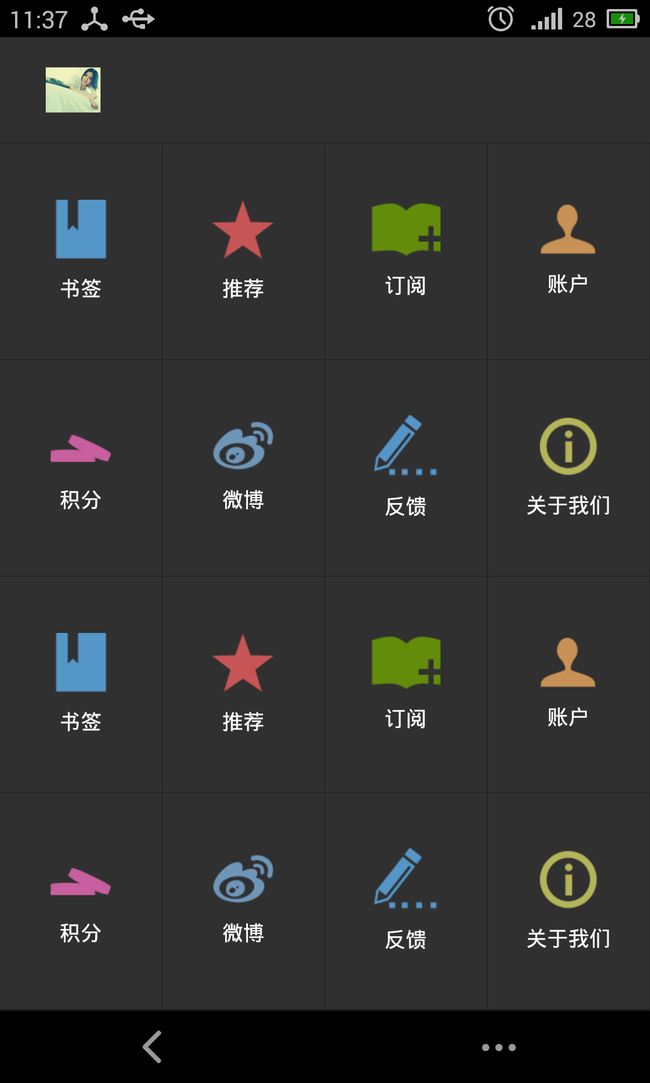【Android】格子布局(类似锤子桌面布局)
转载:
http://www.devstore.cn/code/info/277.html
利用自定义布局实现了格子布局,用来展示选项,添加了对应的item点击监听,和“锤子”桌面效果差不多。
源码运行截图
源码片段
|
1
2
3
4
5
6
7
8
9
10
11
12
13
14
15
16
17
18
19
20
21
22
23
24
25
26
27
28
29
30
31
32
33
34
35
36
37
38
39
40
41
42
43
44
45
46
47
48
49
50
51
52
53
54
55
56
57
58
59
60
61
62
63
64
65
66
67
68
69
70
71
72
73
74
75
76
77
78
79
80
81
82
83
84
85
86
87
88
89
90
91
92
93
94
95
96
97
98
99
100
101
102
103
104
105
106
107
108
109
110
111
112
113
114
115
116
117
118
119
120
|
public
class
MyGridLayout
extends
ViewGroup {
int
margin =
2
;
// 每个格子的水平和垂直间隔
int
colums =
2
;
int
count =
0
;
GridAdatper adapter;
@SuppressLint
(
"Recycle"
)
public
MyGridLayout(Context context, AttributeSet attrs,
int
defStyle) {
super
(context, attrs, defStyle);
if
(attrs !=
null
) {
TypedArray a = getContext().obtainStyledAttributes(attrs,
R.styleable.MyGridLayout);
colums = a.getInteger(R.styleable.MyGridLayout_numColumns,
2
);
margin = (
int
) a.getInteger(R.styleable.MyGridLayout_itemMargin,
2
);
}
}
public
MyGridLayout(Context context, AttributeSet attrs) {
this
(context, attrs,
0
);
}
public
MyGridLayout(Context context) {
this
(context,
null
);
}
@Override
protected
void
onMeasure(
int
widthMeasureSpec,
int
heightMeasureSpec) {
count = getChildCount();
if
(count ==
0
) {
super
.onMeasure(widthMeasureSpec, widthMeasureSpec);
return
;
}
for
(
int
i =
0
; i < count; i++) {
final
View child = getChildAt(i);
if
(child.getVisibility() == GONE) {
continue
;
}
child.measure(MeasureSpec.UNSPECIFIED, MeasureSpec.UNSPECIFIED);
}
super
.onMeasure(widthMeasureSpec, heightMeasureSpec);
}
@Override
protected
void
onLayout(
boolean
changed,
int
l,
int
t,
int
r,
int
b) {
int
height = b - t;
// 布局区域高度
int
width = r - l;
// 布局区域宽度
int
rows = count % colums ==
0
? count / colums : count / colums +
1
;
// 行数
if
(count ==
0
)
return
;
int
gridW = (width - margin * (colums -
1
)) / colums;
// 格子宽度
int
gridH = (height - margin * rows) / rows;
// 格子高度
int
left =
0
;
int
top = margin;
for
(
int
i =
0
; i < rows; i++) {
// 遍历行
for
(
int
j =
0
; j < colums; j++) {
// 遍历每一行的元素
View child =
this
.getChildAt(i * colums + j);
if
(child ==
null
)
return
;
left = j * gridW + j * margin;
// 如果当前布局宽度和测量宽度不一样,就直接用当前布局的宽度重新测量
if
(gridW != child.getMeasuredWidth()
|| gridH != child.getMeasuredHeight()) {
child.measure(makeMeasureSpec(gridW, EXACTLY),
makeMeasureSpec(gridH, EXACTLY));
}
child.layout(left, top, left + gridW, top + gridH);
}
top += gridH + margin;
}
}
public
interface
GridAdatper {
View getView(
int
index);
int
getCount();
}
/** 设置适配器 */
public
void
setGridAdapter(GridAdatper adapter) {
this
.adapter = adapter;
// 动态添加视图
int
size = adapter.getCount();
for
(
int
i =
0
; i < size; i++) {
addView(adapter.getView(i));
}
}
public
interface
OnItemClickListener {
void
onItemClick(View v,
int
index);
}
/**
* 设置item点击事件
*
* @param click
*/
public
void
setOnItemClickListener(
final
OnItemClickListener click) {
if
(
this
.adapter ==
null
)
return
;
for
(
int
i =
0
; i < adapter.getCount(); i++) {
final
int
index = i;
View view = getChildAt(i);
view.setOnClickListener(
new
View.OnClickListener() {
@Override
public
void
onClick(View v) {
click.onItemClick(v, index);
}
});
}
}
}
|
